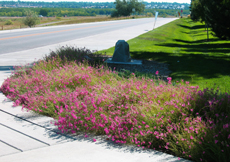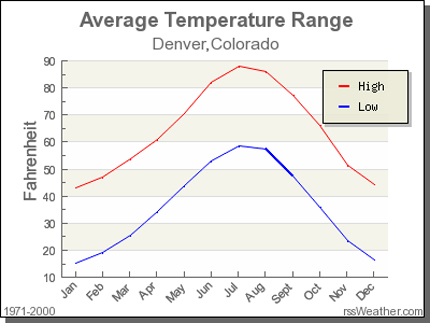Important Summer Landscape Maintenance Tips
What a summer we are having- wildfires, heat, and drought. Hopefully you have already renovated your landscaping to make it more adapted to our climate. The old “imported” landscaping look of  bluegrass and high water-use plants is really showing it wear in this heat.
bluegrass and high water-use plants is really showing it wear in this heat.
Assuming you followed most of the suggestions in my spring landscape maintenance tips, you got the summer started on the right foot. This will allow you to relax a little more over the summer to enjoy your landscape and barbecues with family and friends. But with summer is full swing and the west abound in hot temperatures, there are a few important landscape maintenance tasks that you will want to keep up with.
Key Dates / Weather Considerations
- The month of July: July is Colorado’s hottest and driest month. Take a look at the bar chart below showing the spike in temperature during July. This means that watering will need to be increased for bluegrass lawns and even many of the xeriscape plants.

- On average, we also actually see a spike in precipitation in July. But this is usually due to large afternoon storms, rather than consistent rainfall. We may go 2 weeks with 100 degree temperatures and no rainfall. Then there may be afternoon monsoon storms for 3 days in a row. It is important to monitor the moisture that your plants are receiving, but also watch for flooding and erosion that can occur in bed areas, and around walls, patios, and other hardscapes from these large storms.
- Hail can also be a factor (fingers crossed that it won’t), although I have found that the more native and regionally adapted the landscape is, the more it can recover from being decimated by hail. Plants seem to have evolved to expect hail in this region of the country.
Trees and Shrubs
- Monitor soil moisture. Provide supplemental watering and/or increase watering times on your drip irrigation system during hot, dry periods.
- Watch for pests and manage them accordingly, as many insects will attack plants when they are under stress from drought.
- Assess which of your plants are under stress from the heat- Consider moving plants that prefer more moisture and shade to a different, more shady location so they will be happier next year. But don’t do any transplanting now, it’s too hot- wait until late August at the earliest.
Perennials and Ornamental Grasses
- Ornamental grasses do not need much care during this period. Most of them should be thriving right now- enjoy the beauty, movement, and texture that they provide!
- Some perennials that are done flowering can be dead-headed to promote another round of flowers!
- Watch soil moisture closely, and add additional mulch around the base of plants if mulch has thinned out. This keeps the roots cool and helps preserve soil moisture.
Lawns
- Hopefully you have followed the 7 Principles of Xeriscape, and have limited your turf areas to those places that are most practical. This is the season where it really pays off (in improved aesthetics, reduced maintenance, and lower water bills).
- You will probably have to increase watering during the middle of summer. However, keep in mind that many turf grasses such as bluegrass will go dormant (the lawn will turn brown) if not extensively watered. This does not mean that the lawn is dead. It has simply gone dormant, and will green back up when temperatures cool and it receives more rainfall.
- Some weed species can be a problem in lawns during mid-summer, especially if the lawn has gone dormant or partially dormant- the weeds do not have much competition. Consider using weed control products and herbicides. Always handle these products carefully, and consider organic options if they are available.
Planting Beds
- Weeding is important during the summer months. Small weeds can easily be pulled, but if they are let go for several weeks they will grow fast in the warm temperatures, making the job much more difficult. It can be pretty easy, and even enjoyable. Just grab a glass of wine in one hand, and stroll through your garden pulling the small weeds before they get out of hand.
Other
- Protect your bees, butterflies, and hummingbirds. Bees will be abundant on your flowering plants- in many areas of the country bees are disappearing, so be sure not to use pesticides on any areas that my impact your bees!
While spring and fall are probably the most critical seasons for landscape maintenance, summer is a time to relax and enjoy your landscape while trying to keep cool. If you spend a few evenings or cool mornings following some of these summer landscape tips, you will achieve piece of mind and your landscaping will be in great shape.
This is the official blog of Outdoor Design Group, Colorado Landscape Architects. For more information about our business and our services, click here.